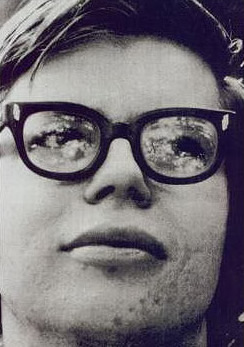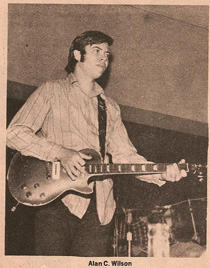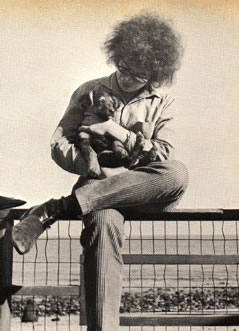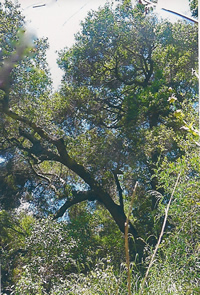Biography
Cofounder of Canned Heat
Alan Wilson is widely remembered as a pioneer of blues-rock during its crucial development period of the 1960s. Wilson’s devoted fans considered him one of the most brilliant, innovative, and sadly under-recognized artists of his era. His recording career spanned only three years, cut short in 1970 by his untimely death. Despite this, he left behind a rich legacy of inspiration to fellow artists, music scholars, and listeners alike.

Born July 4, 1943, Wilson was the second child of Jack Wilson and Shirley Brigham Wilson. His parents divorced when he was four years old and he and his sister, Darrel, remained in their Arlington Massachusetts house with their father and their maternal grandmother, Julia Brigham. Jack married his second wife, Barbara. Barbara and Jack raised Alan and Darrell along with the three children they had together. Shirley also remarried and raised three daughters with her husband, Joe Konecny. In 1954 Shirley moved to New York State, and remained in contact with Alan, Darrell and the Wilson family, visiting back and forth over the years.
Alan’s exceptional intelligence was obvious at a young age. His musical inclinations became apparent when Barbara bought him a jazz record, and he immediately began analyzing what he heard. He learned to play the trombone and taught friends how to play the other instrumental parts of the arrangements.
As a teen, he played trombone in a jazz band he formed called Crescent City. It was the beginning of a lifetime of music scholarship and instrumental prowess. He shared his interest in jazz during summer visits with Joe and Shirley, bringing his favorite LPs to enjoy. Shirley and Joe both played piano and Joe taught vocal and instrumental music in the local school district.
Though his musical explorations began with the trombone and focused largely on instrumental jazz music, Wilson soon discovered the related genre of blues. The first blues record to move him deeply was a Muddy Waters LP, which he appreciated for the power and authenticity of the vocals as well as the slide guitar and harmonica. He began to teach himself both these instruments. Over the years he developed an interest in other genres, including Asian forms, African-American gospel, classical, rock, and pop music among others, but his own primary form of musical expression was the blues. Eventually he would give up trombone, and focus on the guitar and harmonica.
Although Alan’s unusual singing voice would be apparent in the unofficial theme song of the Woodstock Festival, “Going up Country,” some of his first singing attempts took place behind a closed bedroom door at home. When a family member overheard him, he was embarrassed. With a style that took its cue from high-pitched blues singer Skip James, Alan’s vocals would end up making Canned Heat’s hit songs instantly recognizable.
In 1961, Alan attended Boston University after graduating from high school. His academics earned him a National Merit Scholarship and a scholarship from the Town of Arlington.
After a year and a half, anxious to play music rather than study it, he quit school. To make ends meet, he worked with his father as a bricklayer and occasionally gave guitar or harmonica lessons. It was an exciting time, for Alan was immersed in the fertile musical environment of the “folk revival” that was happening in local Cambridge, Massachusetts in the early 1960’s.
Around this time, Alan’s interest in the blues led to his participation in the revival of old blues artists and their music. When newly rediscovered bluesman Booker White played a series of Cambridge gigs, Wilson took the opportunity to interview him. From White, he learned that the seminal 1920s bluesman Son House, teacher to Robert Johnson and Muddy Waters, was still alive. As a result of this interview, efforts to locate Son House were successful.
When Son House came to Cambridge, Alan helped resurrect guitar parts and songs that the elderly man hadn’t played in decades, due to his decline into alcoholism. Thanks in large part to Alan’s assistance and inspiration, House recorded a classic album for the Columbia record company and enjoyed a successful career playing for “blues revival” audiences. Alan would later appear on two of Houses’ albums, “Father of the Delta Blues” and “Delta Blues and Spirituals,” playing harmonica and guitar.
Another figure involved in this scene was the quirky, iconoclastic guitarist John Fahey, who had been involved in the rediscoveries of Skip James and Booker White. In later years, he would become known as a founder of the “American Primitive” guitar style. In 1965, Alan had been listening to Fahey’s records, and at a gig in Cambridge the two struck up a friendship that would change Alan’s life.
 Fahey was attending UCLA and writing a thesis on Charlie Patton, who is nowadays known as the “father of the Delta blues.” Recognizing Alan’s interest and scholarship, he asked Alan to accompany him back to California to help him with music theory and notation for the thesis in exchange for room and board. Alan accepted the offer and moved to Los Angles with Fahey.
Fahey was attending UCLA and writing a thesis on Charlie Patton, who is nowadays known as the “father of the Delta blues.” Recognizing Alan’s interest and scholarship, he asked Alan to accompany him back to California to help him with music theory and notation for the thesis in exchange for room and board. Alan accepted the offer and moved to Los Angles with Fahey.
On the journey, the forgetful Alan Wilson left his eyeglasses in Massachusetts. Because of his poor vision, Fahey began calling him “Blind Al”, in the style of old-time blind musicians such as Blind Lemon Jefferson, Blind Willie Johnson, Blind Blake, and so on. Eventually, because of Alan’s roundish facial features combined with his scholarly nature, the name became “Blind Owl”. In later years, it became Alan’s blues moniker with Canned Heat.
In Los Angeles, Fahey introduced Wilson to a record store manager named Bob Hite who had an encyclopedic knowledge of music, and a record collection that some have recalled as one of the world’s largest at the time. Hite sang the blues in a classic “belter” style comparable to that of Big Joe Turner. He was a natural musical complement for Alan. The two men could not have been more different, however, in terms of their personalities. Hite was loud and outgoing; Wilson was quiet and introverted. Alan was the meticulous creator of music; Bob was the over-the-top showman. Their partnership, though, provided an unlikely balance, and was the basic chemistry for Canned Heat.
Hite and Wilson decided to form a jug band along with Fahey. When someone proposed the idea of going electric, Fahey lost interest, and would be replaced by a short succession of electric guitarists culminating with Henry Vestine. With influences from Albert King, Albert Collins, B. B. King, and other masters, Vestine made his guitar speak a psychedelic blues language that fit perfectly with Wilson’s concept for the band and the music of the era.
The band decided to name themselves after an obscure record by 1920s-era bluesman Tommy Johnson. Thus, they were originally “The Canned Heat Blues Band”, but after discovering that local interest in blues was tepid at best, decided to shorten this to “Canned Heat.” With a lineup of Hite on vocals, Wilson on bottleneck, rhythm guitar, and harmonica, and Vestine on lead guitar, they were made complete by bassist Larry Taylor and drummer Frank Cook. In this incarnation, they played local fraternity events, private parties, and the like. Eventually they played a party where they caught the attention of Hollywood agent Skip Taylor, who became their manager.
In 1966, the band had recorded a batch of demos for R&B producer Johnny Otis. For the time being, the songs were shelved, and would eventually be released on Janus Records in 1970 as Vintage Heat. But their first official LP release came when Skip Taylor secured a recording contract with Liberty Records.
The album, Canned Heat, stayed true to the band’s blues roots, presenting material going back as far as the 1920s in a modern, electric band format. It included songs like “Big Road Blues”, “Catfish Blues”, and “Rollin’ and Tumblin’”. The only item featuring Wilson’s vocals was a version of Sonny Boy Williamson’s “Help Me”.
Canned Heat’s first nationwide tour included the historic Monterey International Pop Festival. The national tour was suspended briefly due to a drug bust in Denver. The arrests did not include Alan, who was outside collecting leaves while the other band members partied in their motel rooms with, unbeknownst to them, undercover drug agents.
This retreat into nature was not uncommon for Alan. It may have been his shyness and social awkwardness that made him feel more comfortable when surrounded by nature, or reading books on botany. He felt ill at ease with the rock and roll lifestyle, not knowing how to relate to women as his band mates so easily did.
Alan had a special love of trees, and now that he lived on the West coast, found a virtual heaven on earth in the ancient coastal redwood forests. In 1969, Bob Hite gave him a camper for his birthday, knowing how Alan would go off into the woods during his time off tour. He usually spent his nights outside in a sleeping bag, often cooking his dinner of brown rice over a portable stove. He also had an interest in yoga, and was known to practice yoga positions and breathing exercises often which he felt improved his harmonica playing.

In late 1967, drummer Frank Cook was replaced by Fito de la Parra, whose affinity to the blues would prove essential to the “classic” Canned Heat sound. This lineup recorded their third album in 1968, Boogie With Canned Heat, and released a single containing an unusual raga-like harmonica blues, “On the Road Again.” Alan not only sang the lyrics, but played a variety of instruments, layered in multiple tracks. This song expressed his deep interest in classical Indian music. Musicologically, it has certain key affinities with pentatonic blues, which Alan recognized and used to good effect here.
Surprising everyone and breaking out as a hit in Texas before spreading nationwide, “On the Road Again” peaked at number 16 on the Billboard Hot 100. In the UK, it reached number 8 on the singles charts, forecasting Canned Heat’s immense popularity there and in Europe. This was quite an achievement given the tunes unusual sound compared to other popular music of the era.
At this point, Wilson’s musical expertise was guiding the group’s musical direction. The 1969 album, Living the Blues, featured “Going Up Country” which reached number 11 on the singles charts and would become the unofficial theme song of the Woodstock Festival movie soundtrack. For decades, it has been used in movie soundtracks, television commercials, and other media worldwide, and for many represents the “hippie” era of the 1960s. Other songs on the album showed the band’s interest in experimentation and psychedelia.
The success of the hit “Going Up Country” and the band’s previous performance at the Monterey Folk Festival no doubt secured the invitation of Canned Heat to appear at the Woodstock Festival in Bethel, New York, in August 1969. Just prior to the event, lead guitarist Henry Vestine, whose performances had begun to suffer from drug and alcohol abuse, left the band and was replaced by Harvey Mandel, a Chicago guitarist noted for his innovative approach to blues and jazz-influenced rock. The Harvey Mandel era of the band saw the release of the Future Blues album along with successful and lucrative tours across the US, UK, and Europe.
Despite the band’s commercial success, on a personal level, Alan Wilson was suffering. An extremely sensitive individual, he had long been prone to depression, and struggled to interact with others on mundane social levels. An inability to find a suitable romantic partner also weighed upon him, and at various times he considered leaving Canned Heat.
To contribute something for the world of a nature he loved, which he saw increasingly endangered by pollution and urban sprawl, Alan decided to create a conservation fund. Music Mountain, as it was called, was an organization to raise money for the preservation of the coastal redwood, his favorite tree species. The liner notes for the album Future Blues, written by Wilson, celebrate the beauty of the redwood forest and beseech the reader to contribute to the Music Mountain cause.
By the time lead guitarist Henry Vestine returned to the band in 1970, Wilson had begun expressing suicidal thoughts. He sought help through a therapist, as well as inpatient treatment for a period in a psychiatric hospital. Though he was treated with some of the antidepressants of the time, he also continued to self-medicate a sleeping problem by using illicitly obtained barbiturates.
Fulfilling a lifelong dream for the band, Canned Heat teamed up with John Lee Hooker in May 1970 to record a double album. This also served as an effort to engage Wilson, providing him with some musical satisfaction and the accomplishment of recording with one of his artistic idols. The resulting album, Hooker N’ Heat, was critically acclaimed.
On September 2, 1970, Canned Heat was scheduled to leave for a European tour. Alan didn’t show up at the airport, which didn’t raise immediate alarm because he was often late and disorganized in the past. This time, however, he would not appear. On the morning of September 3, a group of friends found him dead in Bob Hite’s backyard. He was 27 years old.
The backyard of Bob’s home in Topanga Canyon had been one of Wilson’s regular haunts when the band was in Los Angeles, with a hillside covered in trees and bushes where he liked to sleep. It was there that he was found in his sleeping bag. In his pants pocket were a few of the barbiturates he habitually used to get to sleep. The Los Angeles coroner ruled his death “accidental acute barbiturate intoxication.” Some close to him felt that his death was no accident, recalling his recent depression and hospitalization. Others, like the coroner, thought that evidence of a suicide was insufficient, and that the circumstances point to a tragic accident.
We will never know what Alan Wilson was thinking that night, as he unrolled his sleeping bag and looked up at the stars one last time. What we do know is that he was a talented musician and musicologist who promoted the revival of early Delta blues and left his own permanent mark on the blues and the music of the late 1960s. He was an environmentalist at the beginning of the modern environmental movement. He struggled with emotional issues and social awkwardness, and his life was cut short either accidentally or recklessly as a result of drug use. We also know that he was and still is loved, remembered and missed by his living relatives, including Barbara, Shirley and Joe, his sisters and brother, Darrell, Heidi, Lisa, Nicole, Sharon, David, Jayne, and all his nieces and nephews who never got to know him. We hope that this web site is a fitting tribute to his life.